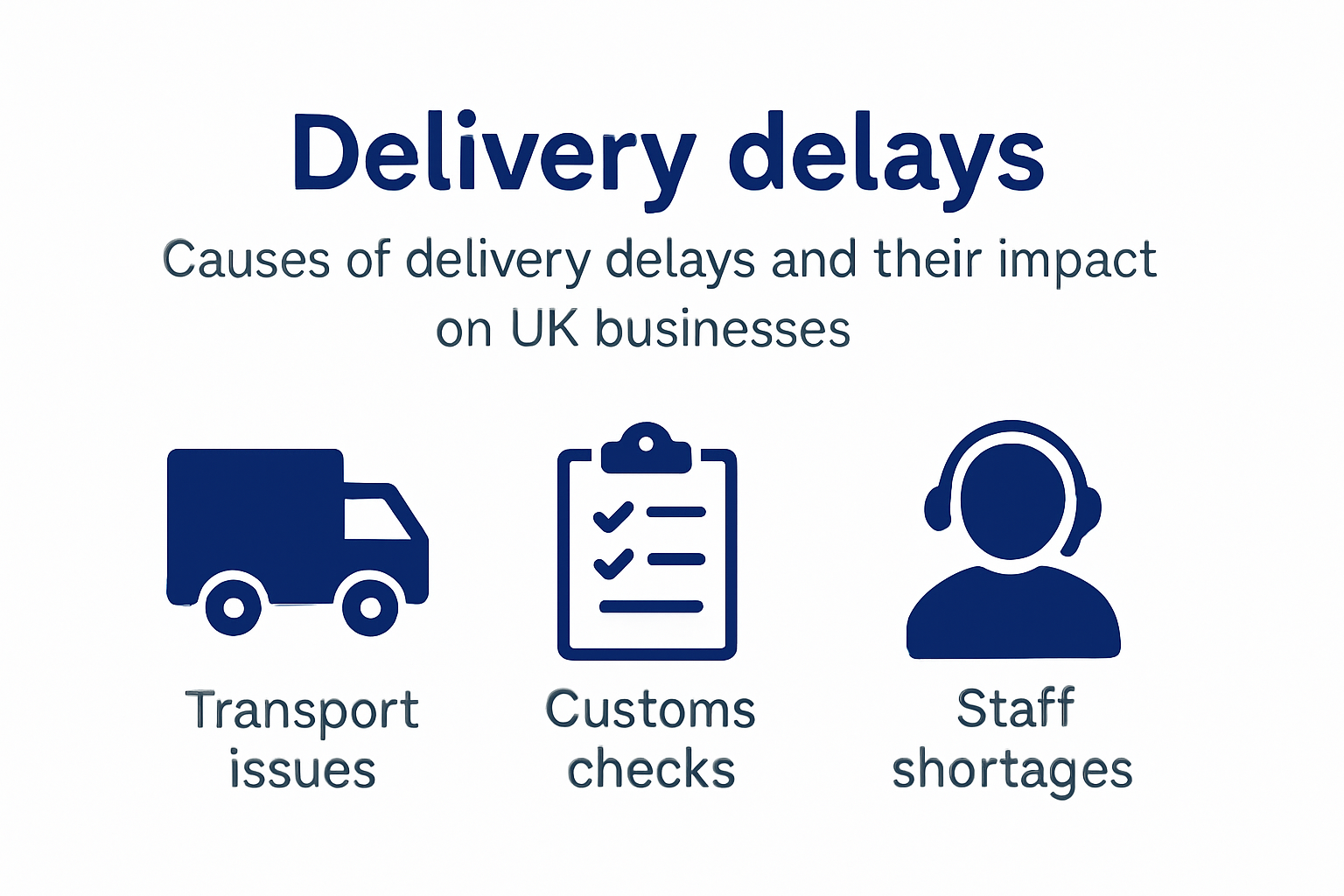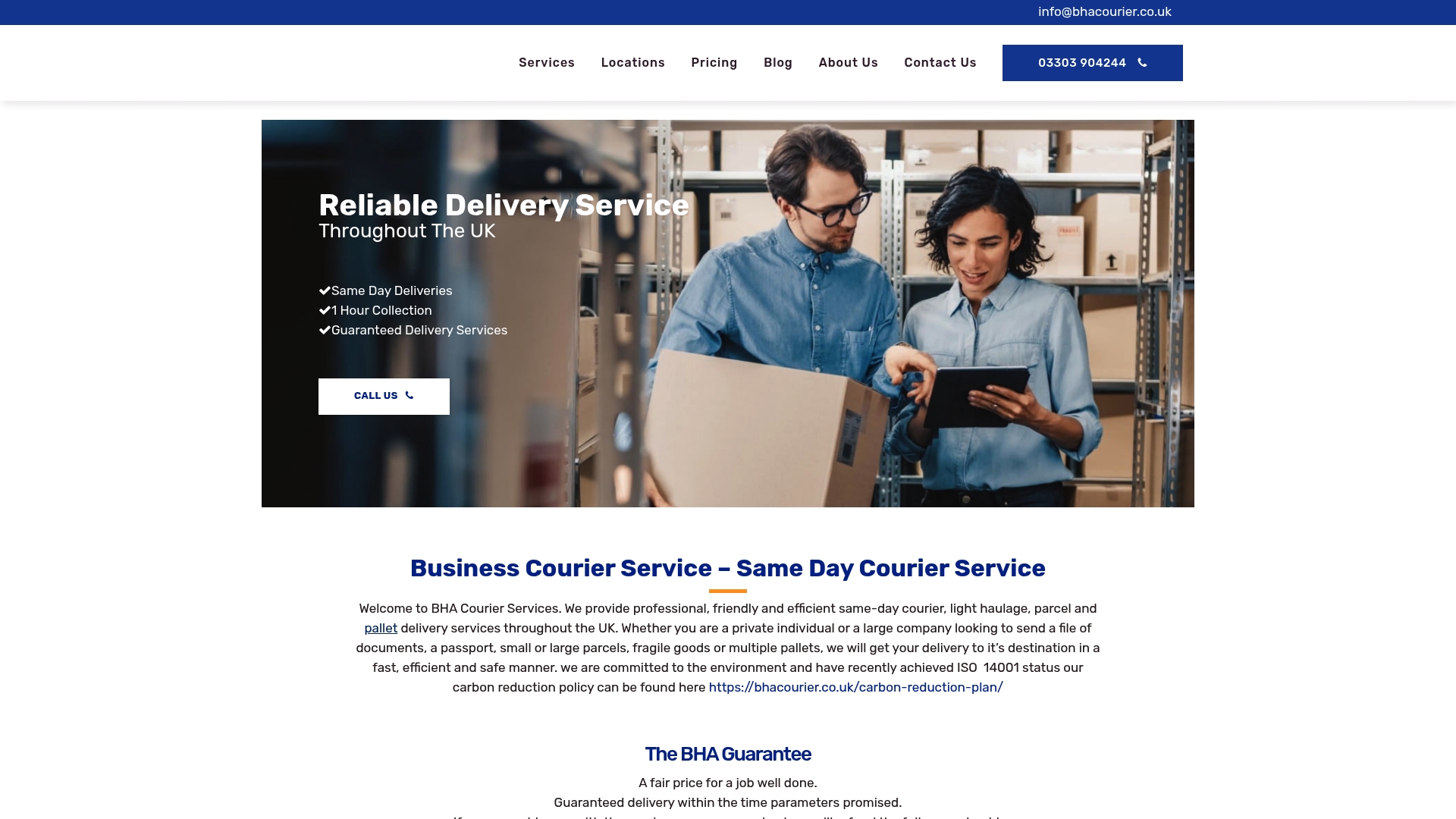
19 Jul What to Do if Delivery Is Late: Practical Steps for UK Businesses 2025

Deliveries running late can leave UK businesses scrambling and customers fuming. Yet over 60 percent of UK firms reported at least one major delivery delay in 2024 and that number keeps climbing. Most expect technology to solve everything but stronger relationships and quick thinking often have a bigger impact than high-tech solutions when the clock is ticking.
Table of Contents
- Understanding Why Deliveries Get Delayed
- Immediate Actions When A Delivery Is Late
- How To Communicate With Delivery Partners And Customers
- Preventing Late Deliveries In The Future
Quick Summary
| Takeaway | Explanation |
|---|---|
| Understanding Delays | Acknowledge that complex supply chain dynamics, external factors like severe weather, and technological limitations contribute to delivery delays, necessitating proactive management strategies. |
| Immediate Communication | Promptly contact logistics partners and affected customers, providing clear information about delays and developing risk mitigation strategies to maintain trust and operational integrity. |
| Preventative Measures | Invest in advanced data analytics and foster strong supplier relationships to create resilient delivery systems that anticipate issues before they occur, enhancing overall service reliability. |
Understanding Why Deliveries Get Delayed
Delivery delays can significantly impact businesses, causing frustration for customers and potential financial losses. Understanding the underlying reasons for these disruptions is crucial for developing effective strategies to mitigate their effects.
Complex Supply Chain Dynamics
Modern delivery systems involve intricate networks of logistics, transportation, and coordination. Multiple factors can contribute to delays, creating a complex web of potential interruptions. Research from the U.S. Government Accountability Office highlights several key reasons for delivery disruptions, including increased consumer demand, workforce shortages, and transportation bottlenecks.
The pandemic fundamentally transformed global supply chains, exposing vulnerabilities that were previously hidden. Businesses now face unprecedented challenges in maintaining consistent delivery timelines. Workforce shortages have become particularly problematic, with logistics companies struggling to recruit and retain skilled personnel capable of managing increasingly complex delivery requirements.

External Factors Impacting Delivery Reliability
External factors play a significant role in delivery delays. Weather conditions, transportation infrastructure issues, and regional conflicts can create unexpected disruptions. According to Logistics Management Research, transportation networks are increasingly susceptible to systemic breakdowns.
Key external factors include:
- Severe weather events interrupting transportation routes
- Infrastructure limitations in certain geographical regions
- Political and economic instabilities affecting global shipping
- Unexpected global events causing sudden logistical challenges
Technological and Operational Challenges
Technological limitations and operational inefficiencies also contribute to delivery delays. Outdated tracking systems, inefficient routing algorithms, and manual processing can create significant bottlenecks in the delivery process. Modern businesses must invest in advanced technological solutions to streamline their logistics operations.
Companies need robust systems that can provide real-time tracking, predictive analysis, and adaptive routing to minimise potential delays. This requires significant investment in digital infrastructure and continuous technological upgrades.
Understanding these complex dynamics helps businesses develop proactive strategies to manage and mitigate delivery delays. By recognising the multifaceted nature of logistical challenges, organisations can implement more resilient and flexible delivery systems that adapt to changing circumstances and maintain customer satisfaction.
To provide a clear overview, the table below summarises the main causes of delivery delays as discussed above.
| Cause of Delay | Description | Example Impact |
|---|---|---|
| Supply Chain Dynamics | Complex networks, workforce shortages, high demand | Slower handling and fulfilment |
| External Factors | Weather, infrastructure, geopolitical issues | Route closures, disrupted shipping |
| Technological & Operational Challenges | Outdated IT systems, poor routing, manual processing | Lost tracking, missed deliveries |
Immediate Actions When a Delivery Is Late
When a delivery is late, businesses must act swiftly and strategically to minimise potential negative impacts. Prompt and professional responses can help maintain customer trust and mitigate potential financial or operational disruptions.
Contact and Communicate Immediately
The first critical step when a delivery is late is establishing immediate communication. Citizens Advice recommends clear communication channels for addressing delivery delays. Businesses should immediately contact their courier service or logistics provider to understand the specific reasons for the delay.
Effective communication involves several key actions:
- Gather precise information about the delivery status
- Document all communication with the logistics provider
- Prepare a detailed timeline of the delay
- Identify the exact point of disruption in the delivery process
Transparency is crucial during this stage. Customers appreciate honest and timely updates about potential delivery challenges. Businesses should proactively reach out to affected parties, providing clear explanations and estimated resolution timeframes.

Risk Assessment and Mitigation
The Health and Safety Executive emphasizes the importance of comprehensive risk assessment during delivery disruptions. Businesses must quickly evaluate the potential consequences of a late delivery and develop immediate mitigation strategies.
Risk mitigation steps include:
- Identify alternative delivery routes
- Assess potential financial implications
- Develop contingency plans for affected customers
- Review contract terms related to delivery delays
Businesses should also consider the broader impact of the delay on their supply chain and operational workflows. This might involve rescheduling subsequent deliveries, reallocating resources, or negotiating alternative arrangements with suppliers and customers.
Customer Compensation and Goodwill Management
Addressing customer concerns is paramount when dealing with late deliveries. The UK government’s Prompt Payment Policy underscores the importance of fair and transparent business practices. Companies should have a clear policy for compensating customers affected by delivery delays.
Compensation strategies may include:
- Partial or full refunds
- Complimentary services or future discounts
- Expedited replacement deliveries
- Personal apologies and detailed explanations
These actions demonstrate a commitment to customer satisfaction and can help preserve business reputation during challenging logistical situations. By responding professionally and empathetically, businesses can turn a potential negative experience into an opportunity to showcase their customer service excellence.
Ultimately, managing late deliveries requires a proactive, strategic approach that prioritises communication, risk management, and customer relationships. Swift and transparent actions can help businesses navigate delivery challenges while maintaining customer trust and operational integrity.
To clarify the immediate steps after a delivery is late, the following table lays out the sequence and objectives for each action.
| Step | Key Objective |
|---|---|
| Immediate Communication | Obtain delay details & update partners/customers |
| Risk Assessment & Mitigation | Evaluate business/customer impact and devise alternatives |
| Customer Compensation & Goodwill | Maintain trust with fair compensation and clear explanations |
How to Communicate With Delivery Partners and Customers
Effective communication is the cornerstone of managing delivery challenges, requiring a strategic approach that maintains transparency, builds trust, and minimises potential misunderstandings between businesses, delivery partners, and customers.
Establishing Clear Communication Protocols
The National Institute of Standards and Technology emphasizes the critical importance of structured communication protocols in supply chain management. Businesses must develop comprehensive communication strategies that outline precise procedures for reporting and addressing delivery delays.
Key elements of effective communication protocols include:
- Designated communication channels for different stakeholders
- Clear escalation procedures for unresolved issues
- Standardised reporting templates
- Defined response time expectations
These protocols ensure consistent and professional communication across all levels of delivery management. By creating a structured approach, businesses can reduce confusion and provide a reliable framework for addressing potential disruptions.
Transparent and Empathetic Customer Interactions
Customer communication during delivery delays requires a delicate balance of honesty, professionalism, and empathy. Businesses must provide clear, concise information while demonstrating genuine understanding of the customer’s potential inconvenience.
Effective customer communication strategies include:
- Proactive notification of potential delays
- Precise estimated delivery timeframes
- Detailed explanations of delay causes
- Concrete solutions or compensation options
Customers appreciate transparency and direct communication. By providing regular updates and showing a commitment to resolving their concerns, businesses can maintain customer trust even during challenging logistics scenarios.
Collaboration and Relationship Management with Delivery Partners
Building strong relationships with delivery partners is essential for minimising and managing delivery delays. Businesses should approach these relationships as collaborative partnerships, focusing on mutual problem-solving and continuous improvement.
Strategies for effective delivery partner collaboration include:
- Regular performance review meetings
- Shared digital tracking and communication platforms
- Detailed performance metrics and feedback mechanisms
- Joint contingency planning
Successful communication with delivery partners goes beyond transactional interactions. By fostering open dialogue, sharing insights, and working together to address systemic challenges, businesses can develop more resilient and responsive delivery networks.
Ultimately, effective communication is about creating a comprehensive ecosystem of trust, transparency, and collaborative problem-solving. By implementing robust communication strategies across all stakeholder groups, businesses can transform potential delivery challenges into opportunities for demonstrating exceptional service and professionalism.
Preventing Late Deliveries in the Future
Preventing late deliveries requires a proactive and strategic approach that combines technological innovation, robust supply chain management, and continuous improvement strategies. Businesses must develop comprehensive systems that anticipate and mitigate potential delivery disruptions before they occur.
Strategic Supplier Relationship Management
Forbes highlights the importance of diverse supplier relationships as a critical strategy for preventing delivery delays. Companies should focus on building strong, flexible networks of suppliers that can provide reliable and adaptable logistics support.
Key strategies for effective supplier management include:
- Establishing multiple supplier relationships
- Conducting regular performance evaluations
- Developing collaborative improvement plans
- Creating transparent communication channels
By diversifying supplier networks, businesses can reduce dependency on single sources and create more resilient delivery systems. This approach allows for quick pivoting when unexpected challenges arise, minimising the risk of prolonged delivery interruptions.
Advanced Data Analytics and Technology Integration
Jus Global emphasizes the critical role of data analytics in predicting and preventing delivery delays. Modern businesses must leverage sophisticated technological tools to anticipate and mitigate potential logistical challenges.
Technological strategies for preventing delays include:
- Implementing predictive routing algorithms
- Using real-time tracking and monitoring systems
- Developing AI-powered demand forecasting tools
- Creating automated alert mechanisms for potential disruptions
These technological solutions enable businesses to identify potential bottlenecks before they significantly impact delivery timelines. By using advanced analytics, companies can proactively adjust routes, redistribute resources, and develop more efficient delivery strategies.
Continuous Process Improvement and Training
NetSuite recommends establishing strong collaborative alliances that prioritise shared values and continuous improvement. Businesses must invest in ongoing training and development to enhance their delivery capabilities and adapt to changing logistical landscapes.
Process improvement strategies include:
- Regular staff training on logistics best practices
- Implementing comprehensive performance review systems
- Developing adaptive workflow methodologies
- Creating culture of continuous learning and innovation
By fostering a culture of continuous improvement, businesses can develop more agile and responsive delivery systems. This approach ensures that teams are constantly evolving their skills and strategies to meet increasingly complex logistical challenges.
Preventing late deliveries is not a one-time effort but an ongoing commitment to excellence. Businesses must adopt a holistic approach that combines technological innovation, strategic partnerships, and a relentless focus on continuous improvement. By implementing these comprehensive strategies, companies can build delivery systems that are not just reliable, but truly exceptional.
Frequently Asked Questions
What should I do if a delivery is late?
Contact your logistics provider immediately to gather information about the delay, then communicate transparently with your customers about the situation and any potential alternatives.
How can I prevent future delivery delays?
To prevent future delays, invest in strong supplier relationships, implement advanced data analytics, and continuously improve your logistics processes through staff training and technology upgrades.
What communication strategies work best during a delivery delay?
Establish clear communication protocols, provide timely updates to customers, and maintain an empathetic tone to reassure clients during delivery disruptions.
What compensation can I offer customers for a late delivery?
Consider offering partial or full refunds, complimentary services, or discounts on future purchases to maintain customer goodwill and trust.
Fast Solutions When Timely Deliveries Matter Most
Every minute counts when your business faces a late delivery. As highlighted in the article, challenges like complex supply chain issues, external disruptions, and outdated tracking can leave your team scrambling and your customers disappointed. If you need a partner who truly understands the urgency of time-critical and secure transportation, discover how BHA Courier makes late deliveries a thing of the past. Our same-day and guaranteed next-day services are built to solve the exact pain points described above. Our ISO 14001 certification and nationwide network give you added assurance, even with the most sensitive documents or parcels. Tap into real-time tracking and a responsive team who prioritise your deadlines every single time.

Take immediate action to protect your reputation and keep your customers satisfied. Book directly for reliable, rapid courier solutions by visiting BHA Courier, or explore our secure delivery options for urgent same-day services. Choose BHA Courier now for recognised professionalism, quick onboarding, and total peace of mind when you cannot afford further delays.

Sorry, the comment form is closed at this time.